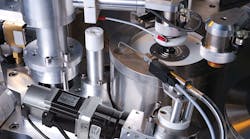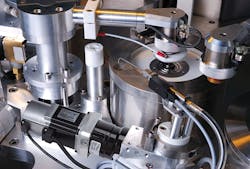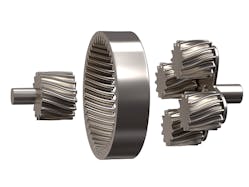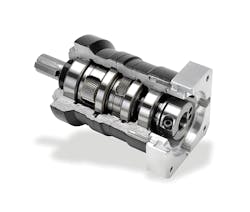With the many industrial gearboxes available today, it’s important to match the proper type of gearbox with the drive, motor, and load. When a machine needs a servosystem (drive and motor), the gearbox type is critical for accurate and repeatable motion. Planetary gearboxes fit the bill for servo applications.
High-precision helical planetary gearboxes are an excellent choice for applications that need accuracy and reliability. Planetary gearboxes have very low backlash ratings (typically ranging from one to nine arc-min), and when sized correctly offer a service life of over 20,000 hours with virtually no maintenance. Helical planetary gears also provide very quiet and more efficient operation as compared to competitive products.
Precision gearboxes are carefully machined to high tolerances – think clockmaker, not blacksmith. They offer power densities that translates to small package size and efficiencies of 90% and greater.
Why use a gearbox?
Servomotors often drive loads directly without the need for a gearbox, but in many applications it’s advantageous to use a gearbox between the motor and load.
One main reason to use a gearbox is torque multiplication. It lets designers use smaller servosystems that consumes less energy. Instead of buying relatively large servodrives and motors, designer can use smaller components, saving space and money.
Output torque increases in direct proportion to the gear ratio, and top speed of the output shaft decreases. If an application can withstand the reduced speed, a relatively small servosystem can supply high torque.
Gearboxes can also address inertia mismatches. For high performance servosystems -- those with high dynamic responses or low overshoot, for example – the ratio between the reflected load inertia and motor inertia should be as low as practical, ideally under ten-to-one. A precision gearbox reduces the reflected inertia by the square of the reduction ratio. For instance, using a 25:1 gearbox reduces the load’s reflected inertia by a factor of 625, a significant improvement.
In some cases, gearboxes simply resolve issues relating to mechanical fit. For example, if directly mounting the motor interferes with another mechanical component, a right-angle gearbox may solve the problem.
Compared to most other gear reducers, a precision gearbox provides better accuracy and repeatability. Furthermore, the gearbox’s high efficiency lets it deliver maximum power available from the servosystem—features often a necessity in servo applications.
This file type includes high resolution graphics and schematics when applicable.
Comparing types of gearboxes
Gearboxes use a variety of power-transmission methods including, but not limited to, planetary gears, worm gears, spur gears, helical gears, and shaft-mount gear units. In servo applications, planetary gearboxes are often the most suitable.
Worm gears use a worm or screw gear to turn a larger transverse gear. They can provide high gear reductions in small packages but aren’t that efficient, on the order of 70%. Worm gears aren’t reversible either and thus can’t be back driven, so they cannot be used to increase speed.
Spur gears use straight-cut teeth on parallel shafts for power transmission. They are available in a wide range of ratios and are cost effective, but they can be noisy and prone to wear.
Helical inline gearboxes also use gears on parallel shafts, but the teeth are cut in helical shapes to allow gradually increasing contact between mating teeth.
Helical inline gearboxes and spur gears typically have more backlash than planetary gearboxes, and there is an undesirable thrust acting along the gear’s axis. Helically cut gear teeth are quieter and are used in other types of gearboxes because of this.
Shaft-mounted gear units are popular for parallel shaft gears, such as spur and helical gears. They are well suited to conveyors and other material-handling applications, and are easy to mount. However, they suffer from the same disadvantages as their constituent parts.
Planetary gearboxes are named for their resemblance to a simple solar system. They consist of a ring gear, several planet gears, and a sun gear. The ring gear is typically fixed and is often part of the gearbox’s outer casing, and the input shaft drives the sun gear.
Rotation of the sun gear drives the planet gears to spin about their own axes and revolve about the sun gear. A carrier attached to the planet-gear shafts harnesses output. This arrangement creates a balanced and compact design that is concentric about the shaft. If multiple stages are needed, it is relatively simple to connect the output of one set of planet gears to the sun gear of a secondary stage.
High efficiency, low backlash, and high power density make planetary gearboxes the best of these alternatives in high-precision servosystem applications.
Selecting gearboxes and servosystems
A servosystem coupled with a planetary gearbox is expected to provide precise motion, but this requires all components be carefully matched. Although it’s possible to buy the servodrive, motor, and gearbox from different suppliers, it’s not recommended as this requires a great deal of research and comparison to ensure all components will work together. Purchasing components from a single supplier — especially one that has carefully matched the components and will stand behind the specific combination of parts in question—offers several advantages.
The supplier has done all the research and confirms compatibility. Most suppliers will extend a more favorable warranty on such purchases. Plus, they can provide the approved mounting hardware to connect the components.
Some suppliers provide online tools for selecting servosystems and compatible gearboxes, easing the specification effort. These selection guides aid the design and provide specific recommendations for closely matched components that can be purchased as a system. In these cases, engineers can be certain the systems they specify are compatible in all critical areas, and that the components will come with the required mounting bushings and keys.
In fact, some selector tools let designers enter their torque and speed requirements, and then automatically filter a list of available motor-and-gearbox sets. Engineers can enter torque data in metric or imperial values, or the designer can select a particular servomotor size. Designers enter speed data as discrete values, or pick a gear ratio. Finally, the engineer can choose a preferred physical orientation—inline, right-angle gearing, or both.
The resulting list of available systems includes pricing information, a factor often critical to the selection process. After choosing a motor/gear combination, the designer moves to a page with full specifications for the selected servosystem, the gearbox, and the combination.
One caveat: Even though a selector can make the specifying process easier, engineers and designers should always verify that a system meets their needs and gets applied correctly.
Best practices and common pitfalls
Although gearboxes help reduce mismatches between the motor’s inertia and that of the load, the gearbox’s inertia must be included in the calculation:
When high dynamic responses are required, engineers need to carefully tune the servosystems, preferably with loads attached, for the most responsive performance. Tuning can provide faster moves and minimize spongy motion while reducing overshoot or ringing after moves are complete.
Designers must also pay attention to radial-load and axial-thrust-load specifications. Axial-thrust load is the force acting along the output-shaft axis; radial load acts perpendicularly to the output shaft.
The force of gravity acting on the load is perhaps the most common source of radial loads, but other sources are possible, depending on the mechanical apparatus attached to the output shaft. Additional external bearings may be required with some loads to minimize these forces and prolong the life of the gearbox’s internal bearings.
A common way to minimize backlash is to approach all target positions from a common direction. In the event a reversing move is required, some designers let the load go past the desired position and return to it from the common direction.
Gearbox applications
One classic example of a precision gearbox application is an indexing table with several stations for machining or assembly. Precision gearboxes and servosystems fit well when the table is relatively heavy and needs to be accurately positioned and when high-speed operation is not as important.
In this case, the gearbox is being used simply for accurate torque multiplication. The servomotor’s top speed of 3,000 to 5,000 rpm is not required at the load, so the gear reduction ratio and corresponding torque multiplication can be large. This allows a relatively small servosystem to handle the task. The servosystem might even use its built-in indexer to control the motion based on discrete I/O signals from aAnother example of a gearbox application is a high-speed pick-and-place device, such as part removal from an injection-molding machine. The cycle time of these machines is often critical to meet production quotas, and the designer typically wishes to remove parts as quickly as possible after the mold opens.
The moving arms of the pick-and-place device are designed to be as lightweight as possible, but inertia mismatch can still be a factor. The gearbox can minimize the mismatch so that the pick-and-place mechanism is extremely responsive.
ThePrecision gearboxes and servosystems can be used to meet a wide range of automation challenges. Machine builders should purchase the required components from a knowledgeable vendor who will stand behind their products. Using online selection tools can simplify the choices, although the system will require tuning after installation. When properly designed, specified, and tuned, these systems provide accurate, repeatable results for many years.





